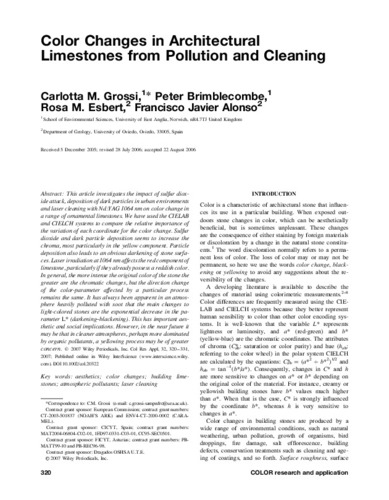Color changes in arquitectural limestones from pollution and cleaningspa
Subject:
Aesthetics
Color Changes
Building Limestones
Atmospheric Pollutants
Laser Cleaning
Publication date:
Publisher version:
Citación:
Descripción física:
Abstract:
Abstract: This article investigates the impact of sulfur dioxide attack, deposition of dark particles in urban environments and laser cleaning with Nd:YAG 1064 nm on color change in a range of ornamental limestones. We have used the CIELAB and CIELCH systems to compare the relative importance of the variation of each coordinate for the color change. Sulfur dioxide and dark particle deposition seems to increase the chroma, most particularly in the yellow component. Particle deposition also leads to an obvious darkening of stone surfaces. Laser irradiation at 1064 nm affects the red component of limestone, particularly if they already possess a reddish color. In general, the more intense the original color of the stone the greater are the chromatic changes, but the direction change of the color-parameter affected by a particular process remains the same. It has always been apparent in an atmosphere heavily polluted with soot that the main changes to light-colored stones are the exponential decrease in the parameter L* (darkening–blackening). This has important aesthetic and social implications. However, in the near future it may be that in cleaner atmospheres, perhaps more dominated by organic pollutants, a yellowing process may be of greater concern.
Abstract: This article investigates the impact of sulfur dioxide attack, deposition of dark particles in urban environments and laser cleaning with Nd:YAG 1064 nm on color change in a range of ornamental limestones. We have used the CIELAB and CIELCH systems to compare the relative importance of the variation of each coordinate for the color change. Sulfur dioxide and dark particle deposition seems to increase the chroma, most particularly in the yellow component. Particle deposition also leads to an obvious darkening of stone surfaces. Laser irradiation at 1064 nm affects the red component of limestone, particularly if they already possess a reddish color. In general, the more intense the original color of the stone the greater are the chromatic changes, but the direction change of the color-parameter affected by a particular process remains the same. It has always been apparent in an atmosphere heavily polluted with soot that the main changes to light-colored stones are the exponential decrease in the parameter L* (darkening–blackening). This has important aesthetic and social implications. However, in the near future it may be that in cleaner atmospheres, perhaps more dominated by organic pollutants, a yellowing process may be of greater concern.
ISSN:
DOI:
Files in this item




